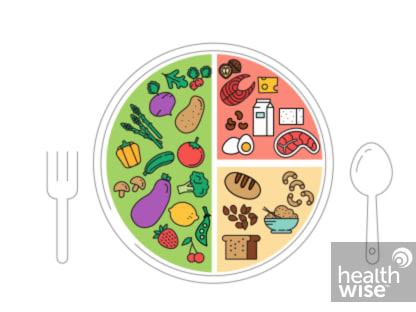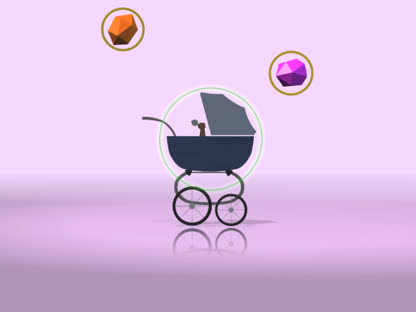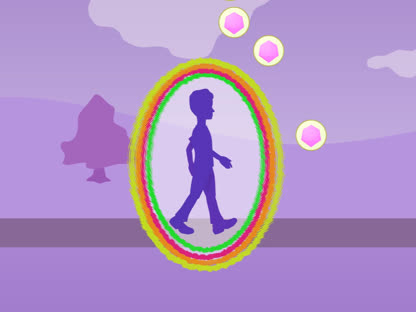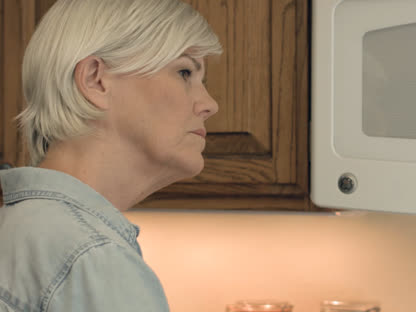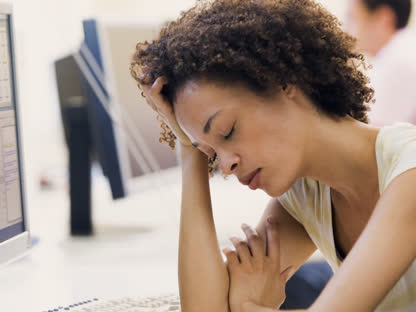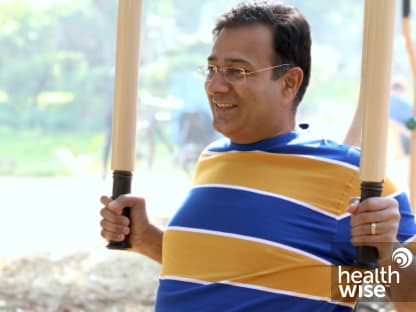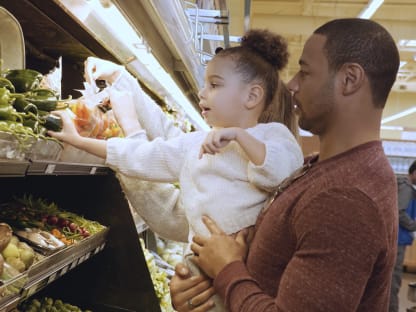Cerebral Palsy
Condition Basics
What is cerebral palsy (CP)?
Cerebral palsy (CP) is a problem that makes it hard for a child to control movement. It's caused by injury to the brain. Usually this injury happens before birth. The brain injury that causes CP doesn't get worse over time, but symptoms may start, change, or become more severe as a child grows.
What causes it?
CP is caused by a brain injury or problem that occurs during pregnancy or birth or within the first 2 to 3 years of life. It can happen if the baby doesn't get enough blood, oxygen, or other nutrients before or during birth. Other causes include premature birth, certain infections, and genetic problems.
What are the symptoms?
CP causes problems with body movement and posture. But symptoms can vary. Some people may limp, while others may have little to no control over some body parts. In some cases, the symptoms of CP are noticed at birth. In others, symptoms aren't clear until early childhood.
How is it diagnosed?
The doctor will do a physical exam and ask about your family's health history and your child's past health. The doctor may ask about your child's growth and development and about any problems you may have noticed. The doctor may also do tests, such as lab tests or an MRI of your child's head.
How is CP treated?
Even though cerebral palsy (CP) can't be cured, you and your child can do things to help deal with symptoms, prevent problems, and make the most of your child's abilities. Physical therapy is one of the most important treatments. Medicines, surgery, and special equipment such as a walker can also help.
Health Tools
Health Tools help you make wise health decisions or take action to improve your health.
Cause
CP is caused by an injury to or abnormal development of the brain. In many cases, the exact cause isn't known. The injury or abnormality may occur during pregnancy or birth or within the first 2 to 3 years of life.
- During pregnancy or birth, possible causes can include genetic problems, infections, or health problems in the mother or baby. Problems related to labor and delivery may also be a cause. Health problems in a newborn, such as untreated low blood sugar, may cause brain damage that leads to CP.
- In an early birth (premature birth), CP is related to the brain's development. For example, babies born too early are at risk for bleeding in the brain.
- Within the first 2 or 3 years of life, CP is usually related to brain injury. It may be caused by a serious illness, trauma, or a lack of oxygen to the brain.
Prevention
The cause of CP sometimes isn't known. But links have been found between CP and certain conditions during pregnancy, birth, and early childhood. Some of these can be prevented.
Before and during pregnancy
Staying healthy before and during pregnancy can help lower the risk that a brain injury will occur in a developing baby. Here are some tips for healthy habits before and during pregnancy.
- Eat nutritious foods.
- Don't smoke.
- Avoid contact with harmful substances.
- See your doctor regularly.
For babies and young children
Help prevent CP in your young child by lowering your child's risk for getting a brain injury.
- Try to prevent accidents, like nonfatal drowning. This helps keep your home safe as your child grows and develops.
- Learn the signs of jaundice in newborns.
- Know how to prevent lead poisoning.
- Keep your child away from people who have serious contagious illnesses, such as meningitis.
- Make sure your child's immunizations are up-to-date.
Learn more
Watch
Symptoms
Everyone who has CP has problems with body movement and posture. But the physical problems vary. People may have:
- A limp or a hard time walking.
- Little or no control over their arms and legs or other parts of the body, such as the mouth and tongue. This can cause problems with eating and speaking.
- Seizures or intellectual disability. This is more likely in people who have severe forms of CP.
Babies with severe CP often have problems with their posture. Their bodies may be either very floppy or very stiff.
As your child gets older, new symptoms may appear, or symptoms may change or get worse.
What Happens
People with CP have a wide range of abilities. The way your child is affected depends on the type of CP they have and how severe it is.
The brain injury that causes CP doesn't get worse over time. But problems related to CP may appear, change, or increase as your child grows. These may include:
- Smaller muscles in the arms and legs affected by CP.
- Problems with sensations. Some people with CP feel pain even when touched lightly. Even everyday activities, such as brushing teeth, may hurt.
- Skin problems caused by moisture. Weakness in the face and throat muscles can cause drooling, which can bother the skin around the mouth, chin, and chest.
- Dental problems caused by trouble brushing.
- Injuries caused by falls and other accidents.
Even though CP can't be cured, treatment can help your child make the most of their abilities and physical strength.
Complications of CP
Some children with CP may have complications, such as seizures, joint problems, or bowel or bladder problems. Other medical conditions, such as vision or hearing problems, are often associated with CP. Sometimes these conditions are known right away. In other cases, they aren't found until a child gets older.
People with CP are at risk for lung disease. For example, severe CP causes problems with eating. If food is inhaled into the lungs, the risk of lung infection (pneumonia) increases.
When to Call a Doctor
Call 911 or other emergency services immediately if your child with CP:
- Is having problems breathing.
- Chokes during feeding and you can't dislodge the food.
Call a doctor now if:
- Your child has a seizure for the first time.
If your child was diagnosed with CP, call your doctor if your child has:
- A seizure. (If it's the first time, call your doctor or seek care right away.)
- Constipation that isn't relieved by home treatment.
- Skin irritation that isn't getting better, starts to bleed or ooze fluid, or causes pain.
- Feeding problems that aren't relieved by home treatment, such as:
- A pattern of coughing and choking during feeding. If food is inhaled into the lungs, it increases the risk of pneumonia.
- Trouble chewing, along with weight loss or complaints of being hungry.
- Falls more often or has frequent events which may endanger your child.
- Other signs of complications. These may include bladder control problems, bleeding gums, or an increase in joint stiffness.
If you have CP and you are pregnant, talk with a doctor about how CP can affect your pregnancy and delivery.
Exams and Tests
The doctor will do a physical exam and ask you about your family's health history and your child's past health. You may be asked about your child's growth and development. The doctor may ask about any problems you may have noticed. Parents are often the first to notice that their baby has problems with certain abilities and skills.
Your doctor may also do tests, such as lab tests or an MRI of your child's head. Or your doctor may look at ultrasound pictures of the brain. These tests can sometimes help the doctor find the cause of CP.
If your child has a severe form of CP, a doctor may be able to find the problem within the first few weeks of your child's life. But even when a baby has CP at birth, the signs may not be noticed until the child is 1 to 3 years old.
Learn more
Treatment Overview
Even though CP can't be cured, treatment can help people make the most of their abilities and physical strength and improve their quality of life. Treatment can also prevent other problems caused by CP.
Treatment varies by the person. It changes as needed. In general, treatment focuses on ways to maintain or improve a person's quality of life and overall health.
Regular visits with your child's doctors are important to monitor your child's condition.
Treatment for CP includes:
- Physical therapy.
-
This can help your child get around as much as possible. It often continues throughout your child's life. It may help prevent the need for surgery.
- Medicines.
-
They can help control some of the symptoms of CP, prevent or minimize problems caused by CP, and treat other medical conditions related to CP.
- Surgery.
-
It may sometimes be used for a person with severe problems. Surgery may help reduce muscle stiffness or spasms. It may also allow more flexibility and control of the affected limbs and joints.
- Devices and equipment.
-
These include braces, casts, and splints. The type of devices used depends on a child's needs. The devices maintain or improve how well joints move, help strengthen muscles and relax overactive (spastic) muscles, and help with daily activities.
- Pain management.
-
This helps your child with short- and long-term pain.
Physical therapy and special equipment may be used together. One example is constraint-induced movement therapy, also called shaping. This encourages a child to move more by presenting interesting activities or objects and giving praise and rewards when a child tries to use the less-functioning muscles.
Ongoing treatment for CP focuses on continuing and adjusting current treatments and adding new treatments as needed.
Working with others involved with your child's care, understanding your child's needs and rights, and taking care of yourself and other family members are all important parts of treatment.
Other treatments
Other treatments may also be needed, depending on specific needs.
- Occupational therapy helps children, teens and adults adapt.
- Speech therapy helps control the mouth muscles. This treatment can be of great help to children with speech or eating problems.
- A registered dietitian can provide nutritional counseling when a child has problems eating or isn't gaining weight.
- Both massage therapy and hatha yoga are designed to help relax tense muscles, strengthen muscles, and keep joints flexible.
- Therapies to help learning and sensory development may benefit babies and young children. Some also help people of other ages.
- Behavioral therapy may help some school-age children with CP learn ways to communicate with others.
- Biofeedback may be useful as part of physical therapy or on its own. Some who use the technique learn how to control muscles or reduce tension.
You may hear about a wide range of controversial treatments for CP, such as electrical stimulation and special diets. Be sure to talk to your doctor about any type of treatment you are considering for your child. Some of these treatments can cause harm.
Learn more
Watch
Self-Care
- Learn about CP. The more you know, the better you can care for your child.
- Take care of yourself. Try to get enough rest, eat well, and exercise.
- Consider joining a support group for families of children with CP. These groups can be a source of information and tips. Your doctor can tell you how to find a group.
- Be safe with medicines. Have your child take medicines exactly as prescribed. Call your doctor if you think your child is having a problem with their medicine.
Help with daily routines
- Discuss physical therapy with your doctor. It can include special exercises and devices, which can help keep your child moving the best they can.
- Talk to your doctor about your child's special needs. Children with CP have different needs, such as bowel or skin care needs.
- Talk to your doctor about how to make your home as safe as possible.
Supporting your teen
The needs of your teen who has CP may change as young adulthood approaches. Here are some tips.
- Give teens and adults with CP plenty of emotional support and understanding.
Family members and friends can help them deal with the daily challenges of having CP.
- Gradually prepare your child for independent living.
Usually teens have learned to use their talents and strengths. But they may need extra help and encouragement to prepare for added expectations and responsibilities. Major independent living skills include preparing meals, managing money, knowing when and where to seek medical care, and using public transportation.
- Talk to your teen about intimate relationships.
Teens and young adults with CP may need more guidance than other people their age in developing these relationships.
Learn more
Watch
Getting Support
Here are some tips to help parents and family members manage the care of a child with CP.
- Learn about the condition.
Being informed can help you understand how best to help your child. Local or national CP organizations can help, especially in dealing with the impact of daily emotional and lifestyle issues. Talk with your doctor for suggestions.
- Learn about your child's educational rights.
Laws in the United States give children with special needs access to free public school services and some free treatments. These educational rights also include protection of the parents' rights to be fully informed about or disagree with educational decisions concerning their child. Contact your state and local education departments for specific information about these accommodations. Also, vocational training may benefit some teens and young adults.
- Work with teachers and school officials.
Work with your child's teachers, school administrators, special learning consultants, and school boards to develop the best educational plan for your child. A cooperative team approach helps your child realize their potential.
- Provide emotional support.
The needs of a child with CP change over time. As children grow and become more aware of their physical limitations, they need to be able to talk about their feelings and how they are treated. It is sometimes easier for them to talk with someone who isn't a family member. Ask your doctor about whether counseling would benefit your child. Also, include your child when making decisions about health care.
- Take care of yourself.
Get proper rest, eat well, exercise, and learn ways to cope with the challenges of raising a child with CP. You will be better equipped to help your child when you have physical energy and emotional strength.
- Help each other.
The entire family is affected when one member has CP. Helping family members cope with this situation is important, especially for siblings. You can help prevent other children from having unrealistic fears and concerns, feeling left out, or becoming overwhelmed.
- Focus on your child's strengths.
You and your family and friends can help your child reach their highest potential. Build self-esteem by helping your child learn to do things without help.
Learn more
Watch
Medicines
Medicines can help control some of the symptoms of CP. They can also prevent or minimize problems caused by CP and treat other medical conditions related to CP.
Treatments for muscle spasms are the most common medicines used for people who have CP. Some are called antispasmodics. They can help relax tight muscles and reduce muscle spasms. Most are taken by mouth. Some are injected directly into stiff or spastic muscles. These medicines include baclofen, diazepam and botulinum toxin.
Anticonvulsants help prevent or control seizures. These medicines include lamotrigine and oxcarbazepine.
Anticholinergics help some people who have CP who have body movements that they can't control (dystonic cerebral palsy) or who drool often. These medicines include benztropine and glycopyrrolate.
Stool softeners and mild laxatives may help treat constipation. This is a common problem for people who have CP.
Learn more
Surgery
Surgery for people who have CP may help reduce muscle stiffness or spasms. It may also allow more flexibility and control of the affected limbs and joints.
The main surgery choices are:
- Orthopedic surgery (for muscles, tendons, and joints). It's done to increase range of motion. Surgery to treat spinal curves (scoliosis) or to prevent or treat hip dislocation is also done.
- Selective dorsal rhizotomy. This is the cutting of nerves of affected limbs for contracture or other mobility problems. This is usually considered only for children who have severe muscle tightness in the legs.
Other surgeries include:
- Surgery for various other orthopedic problems. These surgeries vary depending on the specific problems involved. For example, some children may need surgery to correct uneven leg length.
- Medicine-related surgery. A small pump is surgically placed under the skin in the belly. This pump delivers medicines directly into the fluid surrounding the spinal cord.
Learn more
Devices and Equipment
Many people who have CP benefit from using specific devices and equipment. These may include special crutches, orthotics, casts, standers, special seats, walkers, wheelchairs, and special shoes. There may be other methods used to help with specific problems. These items can help maintain or improve joint mobility. Or they can help strengthen muscles and relax overactive (spastic) muscles. They can also help with daily activities.
The type of device that is used depends on a child's needs. For example, a child may get a cast after surgery. Or a child may get a cast to restrict movement in one area to strengthen muscles and tendons in another part of the body. If both legs are affected by CP, a child can learn to move around with the help of special equipment. These may include a scooter board (a device used to self-propel while lying down), a modified stroller, or a wheelchair.
Related Information
Credits
Current as of: December 3, 2024
Author: Ignite Healthwise, LLC Staff
Clinical Review Board
All Ignite Healthwise, LLC education is reviewed by a team that includes physicians, nurses, advanced practitioners, registered dieticians, and other healthcare professionals.
Current as of: December 3, 2024
Author: Ignite Healthwise, LLC Staff
Clinical Review Board
All Ignite Healthwise, LLC education is reviewed by a team that includes physicians, nurses, advanced practitioners, registered dieticians, and other healthcare professionals.
